How Long Does It Take to Tame a Baby Indian Ringneck
Deciding to go a pet snake tin exist a fun and heady experience for any age.
Whether you are an aspiring herpetologist, looking to join the existing iv.5 million households with reptiles, or are a more experienced handler looking for a beginner snake, this list will assist yous detect the perfect one.
Snakes are very different from companion animals and livestock. Because of this, they accept very different husbandry and intendance requirements. Choosing a beginner ophidian can exist a tricky procedure. You need one best suited for your care and treatment capabilities.
In this commodity, we discuss the top 20 pet snakes that can be handled past beginners based on ease of care, price, and temperament.
xx. Smooth Green Snake
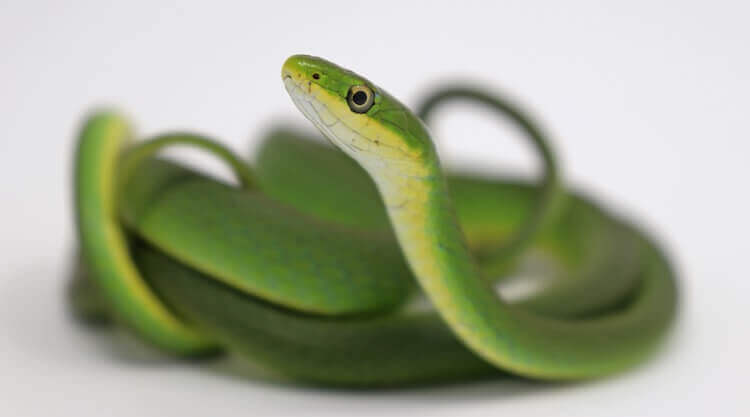
This snake, like the crude version, is native to N America and has a very skinny frame.
Information technology can be housed in a modest enclosure (due east.g. 10 gallon vivarium) and fed insects, simply information technology doesn't tolerate handling very well for long periods of time. They are best suited to someone who wishes to keep a reptile more equally a display animal than a companion.
The Shine Green has similar intendance requirements and temperament to its relative the Rough Green Snake (also featured in this list). What makes this pet rank lower on the list is its availability.
They are harder to come by equally convict bred animals. In that location are simply a handful of breeders and wild defenseless (also as being illegal to keep) can be more problematic for many reasons.
If y'all are a beginner and manage to get a hold of a practiced Smooth Green, they can make a cracking choice.
Although they cannot be handled often, their small size makes for piece of cake husbandry, quick feeding and a nifty learning experience. The longest information technology may live is 15 years, and their price will vary depending on where they come from.
19. Ringneck Ophidian
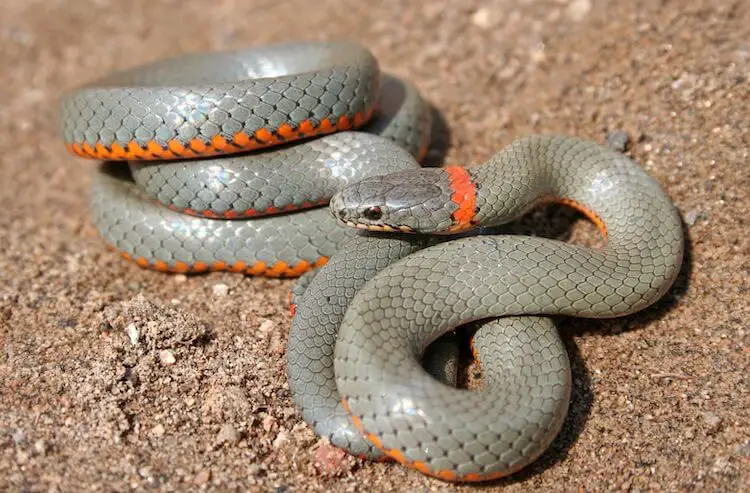
The Ringneck is another native snake to North America and has a distinct yellow or orangish band on their neck (as their proper noun implies).
They are very small, averaging around a pes long.
These snakes normally swallow earthworms and need more husbandry (e.m. proper heating and lighting) than almost others on this list. They are usually docile and tolerate treatment for short periods of time; but may get irritated if they are handled for several minutes with no break.
Although they comport venom to harm their casualty, this venom is not dangerous to humans. Their mouths and teeth are very small, so whatever attempts to bite your finger will exist ineffectively harmful.
Because they are not every bit popular as other pet snakes, they are relatively uncommon. They can live around ten years, but occasionally only live to 6 years in captivity, and cost between $10-$30 USD.
xviii. Rainbow Boa
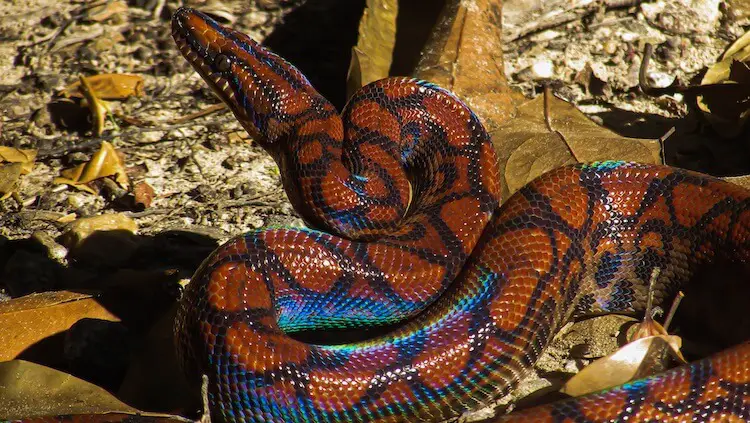
The Rainbow Boa is native to South America and is non usually recommended to beginners for its shy and nippy behavior, but has landed a spot on this listing for its other redeeming qualities.
Starting time and foremost, Rainbow Boas are widely known and appreciated for their stunning colors. In the right light, they have a shiny, iridescent gleam to their skin.
They require specialized husbandry and specific tank conditions of high heat and humidity because of their natural tropical habitat. They may be nippy and shy as babies, merely the correct Rainbow Boa tin can tame downward every bit an developed with frequent handling.
They may be more high maintenance, but the advantage of a gorgeous reptile is a loftier one if the correct corporeality of time and patience is put into their care.
All-time for a beginner who is ready for a large commitment and to acquire virtually correct handling.
Rainbow Boas are typically five-ix feet long and can live to be more than than 20 years old. They are too one of the more expensive pets on our list typically ranging from $200-$600 USD. Some albinos and morphs can be as expensive as $2000-$3000 USD.
17. Carpet Python
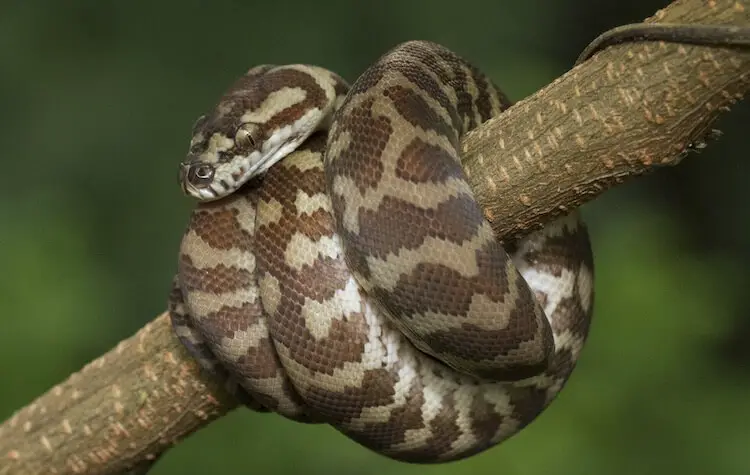
The Rug Python is native to Australia and comes in a variety of colors and several species. This Python is a bit longer than most snakes, reaching 6-6.five feet on average.
These snakes follow most of the same husbandry requirements equally others on this list in terms of: temperature, lighting, and feeding. They will need high temperatures, regular lighting, and consume rodents.
Baby and juvenile Carpet Pythons tend to be very nippy, simply if they grow up existence handled frequently, they tend to be more tolerant every bit adults.
It is for this reason that some beginners like to start with a tamer choice, but this isn't to say that a proficient Carpet Python won't exist a good pet for most.
Most beginners love them for their great variety of colors. They alive upwardly to twenty years and generally cost between $100 to $300 USD.
xvi. Cape Firm Ophidian
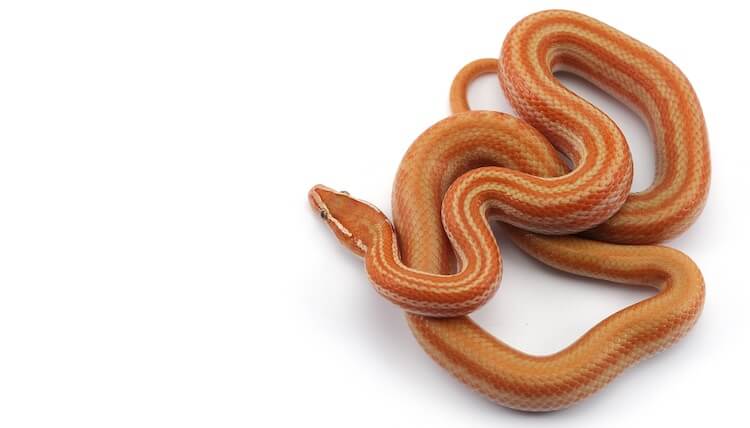
The Brown House is native to Africa and is a length of between ii-4 feet long. They eat mostly rodents and have the basic care and husbandry requirements of about other snakes.
While not an overly popular option, the Brown House is a swell beginner serpent and mostly costs $60-$150 USD.
They by and large take good dispositions and are easily handled afterwards they have been acclimated to their new dwelling house. They're not overly large, and then if they do bite, it should not be a dangerous one.
Unfortunately, they do have a shorter lifespan, typically living for only 8 years.
15. Dekay's Brownish Snake

Though not thought of by herpetologist as a great first snake, many experts hold the right Dekay'due south Chocolate-brown can make a corking outset ophidian for any beginner.
Their habitat does not need to be as large every bit the tanks of other species because of their small size (barely reaching a foot long).
This species is found throughout North America and does non require high temperatures making their husbandry very easy. Dekay's Chocolate-brown Snake is a naturally curious species, and they are normally not stressed by human activity or treatment.
Because they are and then piffling, they eat insects and earthworms rather than minor mammals.
Overall, the husbandry of this pet is on the easier side, depending on your management style, and they tolerate infrequent, gentle handling. They are certainly manageable for a beginner with the right husbandry.
fourteen. African Egg-Eating Snake
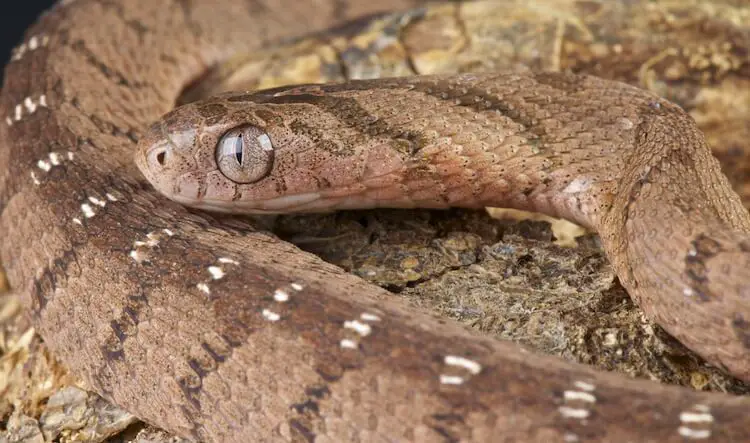
The African Egg-Eating Ophidian, as its proper name suggests, feasts on bird eggs and nothing else.
This is a rare and very specific feeding requirement. It is ane of the few disadvantages of owning this snake.
This species is not terribly large, spanning 2-2.5 feet long, and they range throughout near of Africa.
Feeding this serpent in captivity is 1 of the most difficult parts of their husbandry. They should have finch or quail eggs equally chicken eggs are as well large. However, this may bode well for you if you do not desire to feed rodents.
They come from arid environments, and so they do non need to have high humidity like well-nigh species. Other than this, they take a passive mode of defending themselves, relying on mimicking the colors of more than dangerous reptiles rather than attempting to seize with teeth.
It is impossible for them to bite and harm a human being.
Once they have been handled ofttimes, they are at-home, docile, and are easily handled by a beginner. They live up to 15 years and generally cost $60-$160 USD.
xiii. Rat Snake
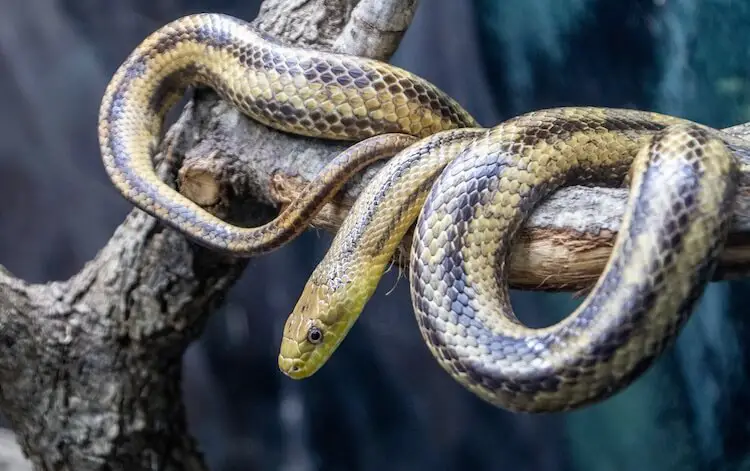
The Rat Snake, though not as popular, is very closely related to the Corn Ophidian, sharing the same genus Pantherophis.
Average sized, reaching iii-five feet, they are ordinarily constitute throughout the United states. They commonly eat rodents and tend to live in wooded areas or in barns.
When they are afraid, they "play dead" and lie motionless instead of hitting.
Similar their Corn Snake cousin, they are very shy and docile, especially if they are handled regularly. They also don't have as much of an analogousness for oestrus. While they should still have high temperatures in their tank, room temperatures volition not damage them.
This docile reptile is piece of cake to care for and can be a cracking beginner snake for any age. They can live up to 30 years and generally cost between $xxx-$300 (depending on the morph).
12. Children's Python

The Children's Python, named by the zoologist John George Children, is a medium-sized python about 2.5-4 feet long that inhabits the rocky areas of Australia.
This reptile is basic in its care requirements and eats mice or rats.
They are not as colorful as many on this listing, merely they can make great pets as they take niggling extra care requirements and have stable temperaments, especially if they are handled frequently and gently.
Children's Pythons tin can absolutely be handled by beginner herpetologists. They can live upwardly to 30 years and generally cost between $70-$350 USD (depending on where they come from).
11. Rough Greenish Serpent
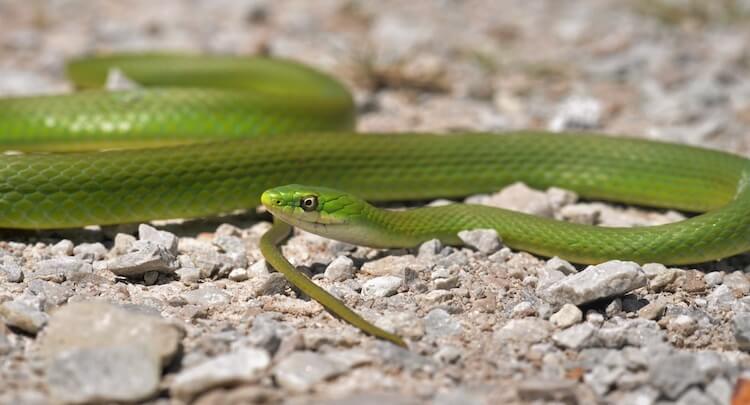
This slender reptile is native to the southeastern The states and northeastern Mexico and can be quite long for their little bodies, reaching upward to ii.five feet long.
They are nigh frequently found in forested areas. Unlike virtually pet snakes, rodents are too big to consume for these reptiles, so they like to eat insects and spiders. In terms of general husbandry and feeding, this snake is easier to intendance for than others.
Rough greens tin alive up to xv years, though many in captivity don't live that long.
While this species is tiny and may be physically easier to handle, they do better in a home where they do not have to be handled as often, as they tin can become stressed and scared.
They are a nifty selection for beginners who would similar to learn about the basics of caring for a serpent and keeping them clean and healthy, only not so much for someone who wishes to frequently handle their snake.
10. Common Boa Constrictor
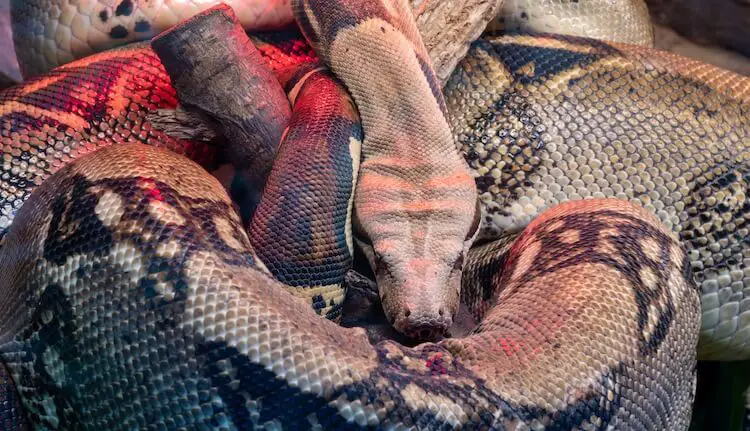
The reason Boa Constrictors are not commonly recommended to beginners is because of their very large size, reaching a whopping 13-16 feet long! They demand a confident handler who is strong enough to hold them.
However, this is not to say that this Constrictor doesn't take the potential to be a good beginner ophidian.
This Boa spans through about of Cardinal and South America. In the wild they consume deer, fish, lizards and other animals. But in captivity they tin eat rats, rabbits, or chickens (depending on their size).
They accept the same general intendance requirements as most snakes, except they will require a bigger enclosure to accommodate their size.
Boa Constrictors are oftentimes tame when they are handled frequently, only they are also very strong and may gyre themselves tightly around yous if they feel threatened.
Because of their big size, this snake is more suited to developed beginners than children.
They are tame and tolerate handling if it is done frequently, and they have the potential to exist a great pet. They live upwardly to 30 years and can price between $lx-$200 USD.
9. Kenyan Sand Boa
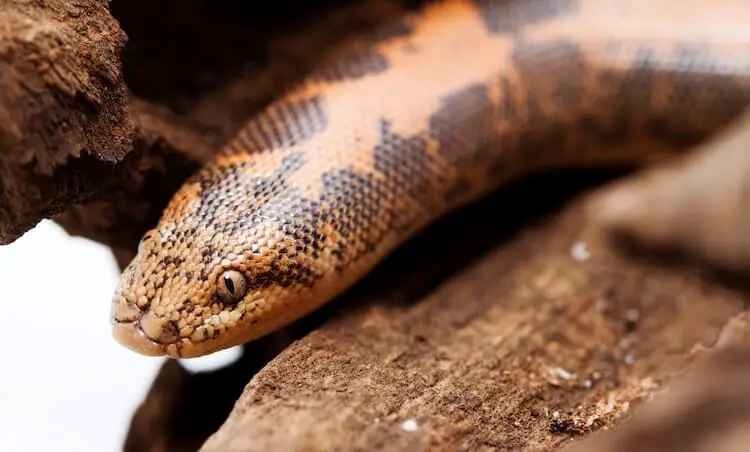
The Kenyan Sand Boa is known for burrowing into the sand, which is exemplified past their aerodynamic shape and smooth scales. These boas also use the sand to suffocate their pinky mice casualty.
This Boa likes rut and needs a warm tank.
1 thing that these reptiles, need that others don't, is several layers of sand on the bottom of the tank for burrowing. This means that the tank may be harder to make clean for beginners than a tank with simple substrates (e.g. newspaper).
The Kenyan Sand Boa is on the smaller size, reaching just a little more than 2 anxiety in length.
They are relatively even-tempered snakes, and would rather squirm away than bite if they don't want to exist handled. They can occasionally be feisty, simply the right sand boa can brand a smashing serpent for a beginner.
Typically costing $75-$200 (depending on the morph), they can live up to 20 years.
8. Western Hognose Serpent
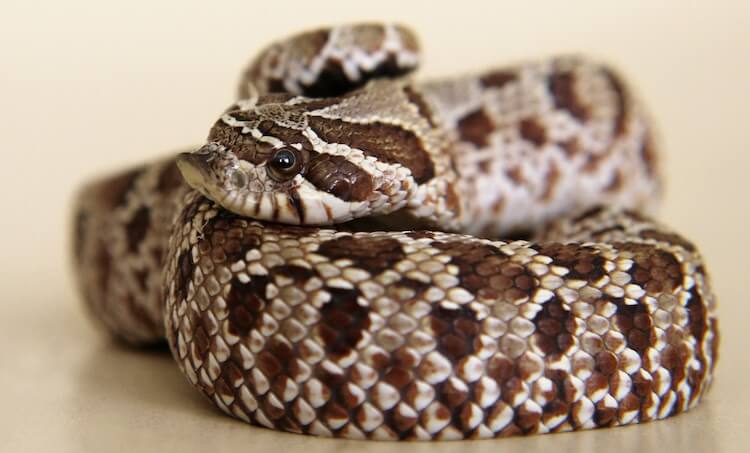
The Western Hognose is native to western parts of the US, as well as southern and northern Canada and Mexico.
They are distinctly known for their upturned noses and are active mostly in the morning and the evening.
In the wild they oft eat smaller lizards and toads. They similar to dig holes in the ground to look for toads buried in the sand, but will swallow mice in captivity if toads are unavailable.
Western Hognoses flatten their heads and hiss when they feel threatened. They may strike, but they are besides known to never bite (even when they feel the most threatened). They would rather play dead.
The hissing they make when threatened is not an ambitious beliefs and they tolerate handling very well. They are expensive as a first snake ranging from between $100-$700 USD.
7. Garter Snake
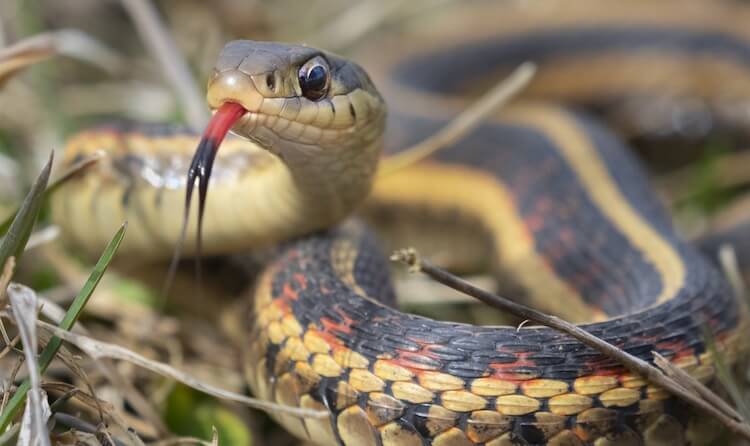
Garters are one of the almost populous wild snakes in the Us, and you tin also discover them every bit a pet in many homes.
These snakes can be fed small fish and worms. Despite their rare diet, they accept common lighting and heating requirements. On the smaller side, they typically reach 1.five-2 feet in length with some reaching four anxiety.
They have a distinct stripe running downwardly their back and tend to savour meadows, marshes, and woodlands, so they enjoy a water source in their tank. They similar to bask in the sun, and so are one of a few beginner snakes which need a basking lamp.
Despite being widely known as a serpent you discover in your backyard (rather than a pet); the Garter Snake is actually a very pop in captivity too.
Even in the wild they are mainly harmless, and tame very easy. They are a great pet for beginners and are hands handled with their gentle and docile nature.
6. Gopher Snake
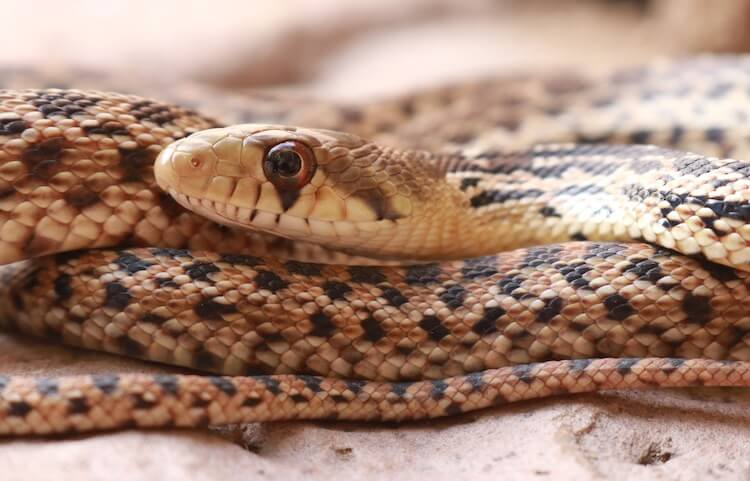
Also known as a Bull or Pino Snake, the Gopher is a reptile native to the western United States.
They are normally mistaken for rattlesnakes, just beginners can easily tell the difference because they take a rounded nose and pupil, and don't have fangs. This reptile can exist either nocturnal or diurnal, simply either fashion is very agile.
These snakes are on the slightly longer side of many on this listing, growing potentially to four.5 feet long.
Like rattlesnakes, they will hiss and shake their tails if they feel threatened, only they are not venomous. Their seize with teeth can be painful, but they simply bite in self-defense.
A captive bred and tamed Gopher should be calm to handle for beginners.
They live up to xx years and like to relish in the dominicus, and so they will require a basking lamp in their vivarium. They price $90-$190 depending on if they are albino or non.
v. Milk Snake
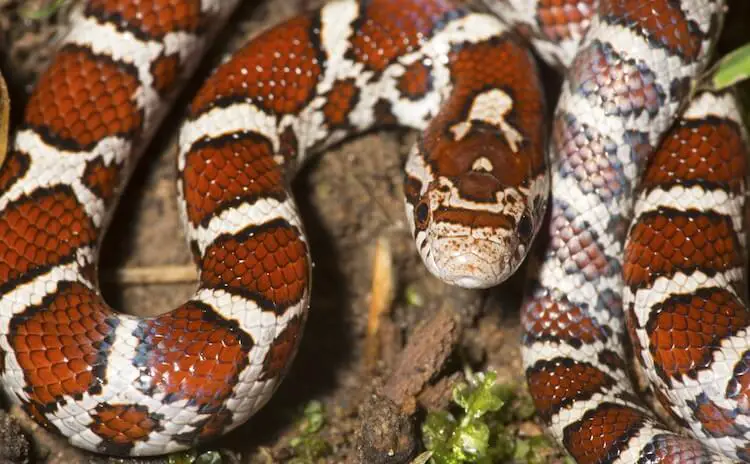
Similar the California King (ranked #2 on our listing), the Milk Snake is actually a divide species of the King Snake.
They are native to the US and United mexican states and commonly take black, white, and red body rings.
Often found in the woods or rocky areas, they do not necessarily like to soak up dominicus, but rather enjoy soaking upwards oestrus from rocks and logs, and then an under tank heater may exist better for them. They otherwise have very basic care requirements and live upwards to twenty years.
Not very large, this reptile can grow up to 2 feet during their first few years.
Like other King species, Milk Snakes are very docile and rarely bite. They are certainly manageable for a beginner herpetologist and typically cost $50-$200 USD.
4. Rosy Boa
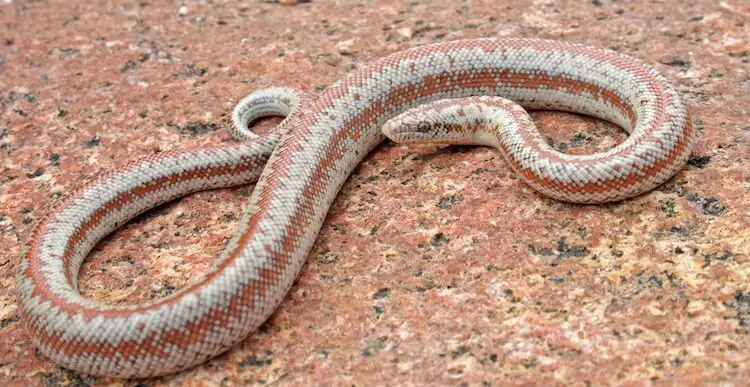
Rosy Boas are a chocolate-brown-rosy-pink color and accommodate to captivity very well. They are commonly found forth the west coast of the United States and parts of United mexican states.
Naturally curious, Rosy Boas hardly seize with teeth or strike and are certainly like shooting fish in a barrel for beginners because they bask existence handled.
They can live up to 30 years in captivity and can cost $25-$350, depending on if you get your snake from a public retailer or a private breeder.
Known for being a docile reptile, they are easy-to-care for and have simple husbandry requirements, butare not quite as popular as the tiptop three snakes on this list!
3. Ball Python
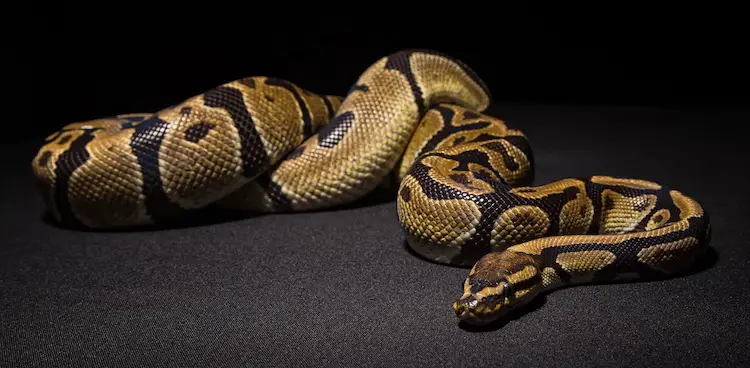
Ball Pythons become their proper noun because of the "ball" they like to curl up in to feel safe.
Native to west and central Africa, they like to live in grasslands, likely burrowing in rodent burrows. They are agile at night and like to stay hidden during the twenty-four hour period.
They are typically chocolate-brown with lighter patches, but convict-bred Brawl Pythons come in a multifariousness of colors. Adults are unremarkably about iii.v-5 feet in length and tin can alive 20-30 years.
Brawl Pythons are docile creatures and are reluctant to bite. They prefer to scroll up in a ball when they feel threatened. They will probable grow out of this behavior if they are handled frequently.
These Pythons eat mice, but it is their dietary-pickiness that makes beginner herpetologists wary. These pythons like to accept their food served freshly killed or thawed.
They typically cost $25-$200, depending on the rarity of the morph. In general, Brawl Pythons are a very common kickoff snake, and aside from their occasional food pickiness, they have an easy intendance routine and are very tame to handle.
2. California King Snake
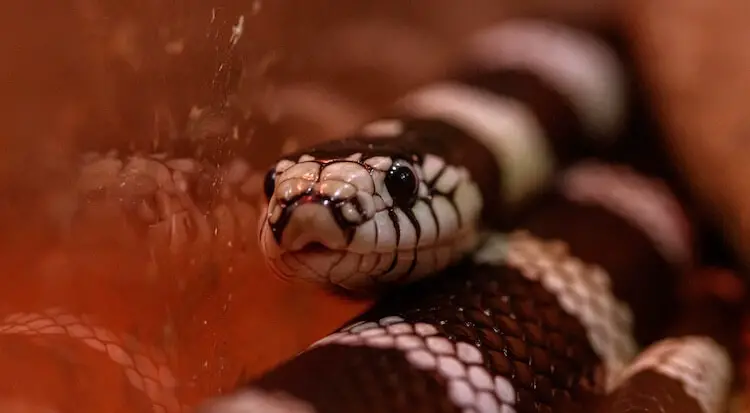
The California Male monarch is the most popular subspecies of Male monarch Snake.
Also native to the United States, they are typically a brownish-blackness color with yellow bands, stripes, or speckles, growing to 2.5-5 feet long (virtually the same size as a Corn Snake). Unlike Corn Snakes, these reptiles are active during the day time instead of dark time. They should, nevertheless, all the same have regular hours of daylight and darkness.
Great for beginners every bit they tin can be housed in a 20 gallon tank. They consume mice in captivity and can live up to 20 years.
This pet can exist shy, only they are very docile with frequent handling. Instead of hitting in anger when threatened, they would rather coil upwards to hide in defense. A reptile well-adapted to handling and living in captivity should not be afraid while it is existence held.
These snakes more often than not cost $70-$170 and accept basic care requirements with the do good of existence easy to handle with their calm temperament.
1. Corn Snake
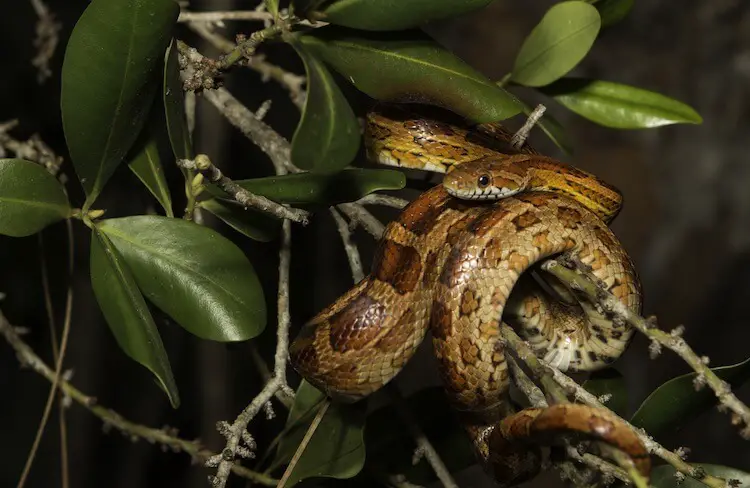
The Corn Ophidian is the most popular beginner serpent.
Native to the United states, they can be institute in terrestrial habitats. These snakes are crimson-brown to orange, typically with dark ruby-red-black blotches, just a variety of colors can be plant in many convict-bred snakes.
Baby Corns are 10-12 inches long and abound to 3-4 feet long. They can exist wild-caught (past professionals), but captive-bred are much healthier with better temperaments.
An developed Corn Serpent tin be kept in a xx gallon aquarium, which is about the size of a medium-large fish tank, and the tank should range from 72℉ to ninety℉ from i side to the other.
They accept petty extra lighting requirements, merely are nocturnal then they should have hours of darkness.
Corn Snakes like to consume pinky mice in captivity. They present very few medical bug, and any issues typically only arise with poor husbandry. They can live upward to 20 years and typically cost between $40-$100.
Overall, they accept a very easy care regimen and a very gentle temperament that makes handling and taking care of them manageable, even for new snake owners!
Summary
There are many pet snakes in our list of 20 which are docile and easy to accept care of making them great for a beginner!
If you are new to keeping reptiles, you should choose which i is the all-time for y'all based on your lifestyle (e.grand. temperament, handling, appearance):
| Species | Easy To Handle? | Husbandry | Price |
|---|---|---|---|
| Dekay's Brown | Aye | Piece of cake | Inexpensive |
| Common Boa Constrictor | No | Advanced | Expensive |
| Ball Python | Yes | Easy | Expensive |
| California Male monarch | Yes | Easy | Expensive |
| Corn Serpent | Yes | Like shooting fish in a barrel | Cheap |
There is a reason why Corn Snakes and Brawl Pythons are then popular; they are like shooting fish in a barrel to care for, enjoy being handled and accept simple husbandry requirements!
Any reptile you choose, you are committing 10-20 years of your life to this animal, and their lives are in your hands.
Let the states know which one is your favorite and if you keep them.
Source: https://www.everythingreptiles.com/20-most-popular-pet-snakes/